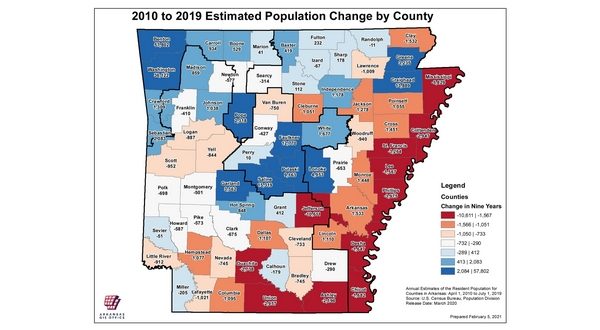
The U.S. Census Bureau estimates Baxter and Boone counties have seen a triple-digit growth in population from 2010 to 2019. Other area counties are estimated to have seen more modest growth or have experienced a population decrease in the hundreds over that same period.The Census Bureau’s 2019 population estimates are being used by the Arkansas Board of Apportionment (ABA) in its series of public meetings on the upcoming redrawing of the map used for the state’s House of Representatives and Senate districts. The ABA is using the 2019 estimates as a stand in for the 2020 Census numbers, which have yet to be released to the state. The actual redistricting will use the 2020 Census numbers.
Boone County in 2019 was estimated to hold 529 more residents than it did back at the 2010 Census. Baxter County also saw an estimated increase in its county population, adding 419 residents compared to its 2010 figure. Fulton County was estimated to have added 232 residents during that same span, and Stone County was estimated to have added 112 residents. Marion County was estimated to have gained 41 residents.
Izard County was estimated to have lost 67 residents between 2010 and 2019. Searcy County’s population was estimated at having declined by 314 during that span, and Newton County was estimated to have lost 577 residents during that nine-year span.
Shifts in county population totals have a direct impact on the shape of the state’s legislative districts.
Under state law, Arkansas is required to have 100 seats in its House and 35 seats in its Senate, and those districts must be “substantially equal,” meaning that each district be within 5% of one another based on total population. According to the 2019 Census Bureau estimates, means each House district should hold about 30,000 residents and each Senate district should count about 85,000 residents.
Counties in northwest Arkansas and the Little Rock metro area saw the largest spike in estimated population from 2010 to 2019, while counties in the Delta reported the steepest population declines.
Benton County is believed to have grown the most between 2010 and 2019, adding an estimated 57,802 residents. Washington County, which borders Benton County, is also believed to have experienced a population boom, adding an estimated 36,122 residents from 2010 to 2019. Saline County in central Arkansas is estimated to have added 15,319 residents during that span, and Craighead County in northeast Arkansas is believed to have added 13,889 residents.
The Census Bureau believes Jefferson County lost the most population between 2010 and 2019, having 10,611 fewer residents in 2019 than it did in 2010. Mississippi County is estimated to have lost 5,829 residents during that nine-year span, while Phillips County is estimated to have lost 3,975 residents.
The ABA’s ongoing series of public meetings about redistricting will be held on the evenings of Tuesdays and Thursday throughout the month from various locations around the state. The meetings can be streamed online through Arkansas PBS.
Twin Lakes Area residents may submit redistricting comments and suggestions by visiting arkansasredistricting.org and clicking on the “Public Comments” tab.
The ABA must complete its work by the end of the year, but faces a time crunch since the release of official figures from the U.S. Census has been delayed about six months and will not be released until this fall. Once the raw data is released, it must be converted into a format the ABA can interpret. Once the revised district maps are completed, the ABA must then wait 30 days for public comment before the new maps can be finalized for use for the next decade.
WebReadyTM Powered by WireReady® NSI










